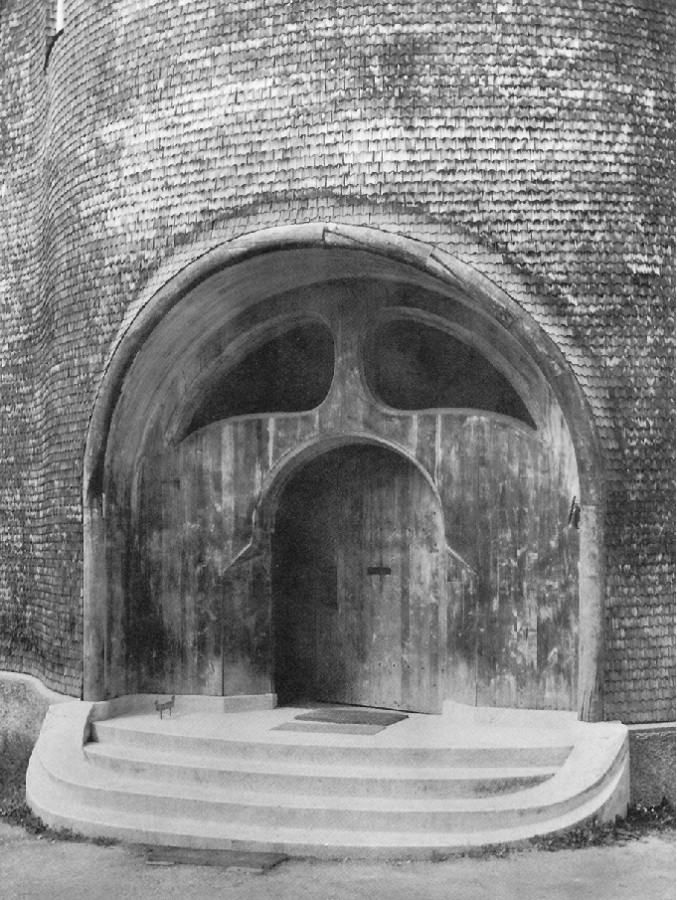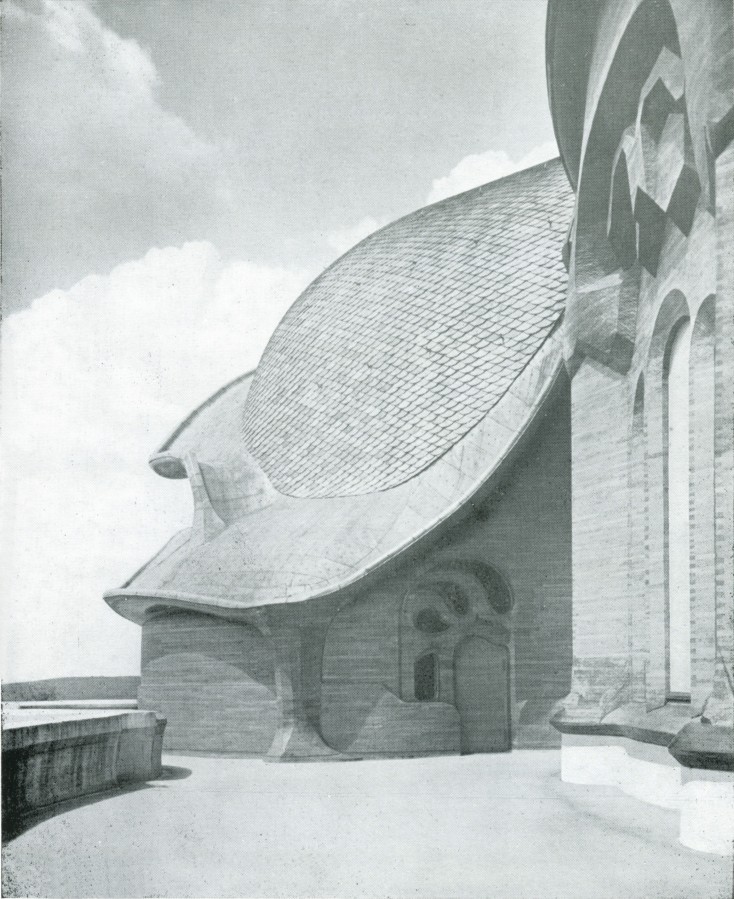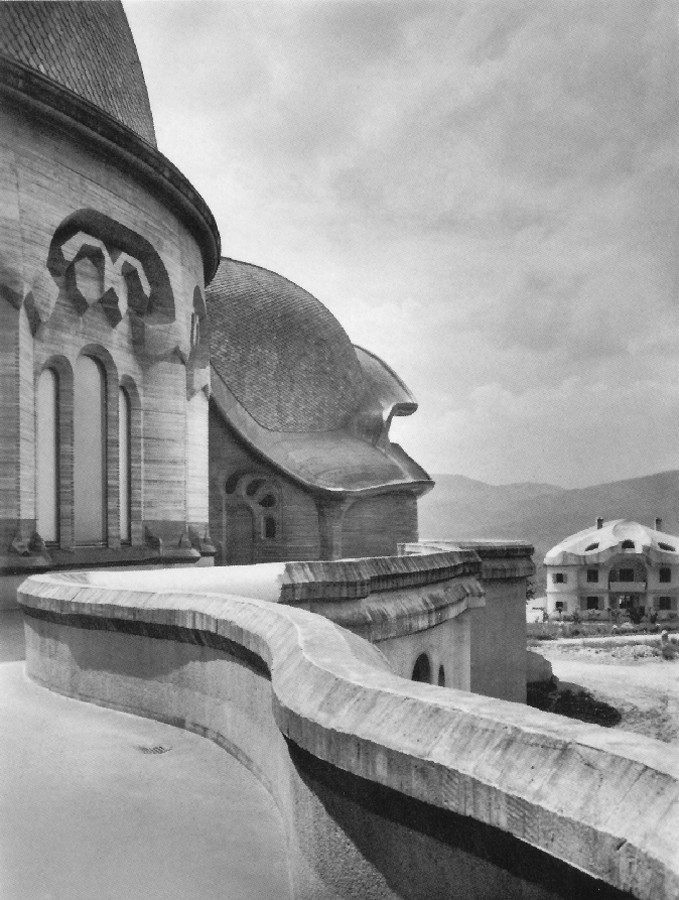Ways to a New Style in Architecture
GA 286
II. The House of Speech
17 June 1914, Dornach
Even more than on the last occasion when I spoke to you about our building am I reminded to-day of the attitude we must have to this edifice, dedicated as it is to the cause of Spiritual Science. The sacrifices of those who have befriended the cause of Anthroposophy call for a sense of great responsibility. To-day is a splendid occasion for reminding ourselves of this responsibility, for the first of our auxiliary buildings is to be given over to its own tasks. We can be reminded of this responsibility by studies that arise naturally out of the tasks before us and the goal we are striving to attain.
The immediate use to which these rooms will be put is the production of the glass windows for our building, and we cannot help being moved by the thought that our human faculties are not really mature enough as yet to accomplish the full task before us. I think it is healthy and good that all our work should be permeated by the feeling that we have not as yet grown equal to our task, for only this can enable us to accomplish the highest that lies within our power. We shall be able to create the first beginnings of an artistic vesture for Spiritual Science—to the extent to which our epoch and our means allow—if we are always pervaded by the feeling that we are, in truth, little qualified for the full task. The site on which our building stands is pervaded by an atmosphere which seems to say: “Do the very utmost of which your powers and faculties are capable, for you cannot do nearly enough in comparison with what ought to be achieved; and even when you have done your very utmost, it will not by any means suffice.”
When we look at the site of our building we should be pervaded by an indefinable feeling—a presentiment that a mighty task is hovering before us. And more particularly should this be the case to-day when we are handing over this auxiliary building to our friend Rychter and his workers, in order that they may create something that in the fairest sense may be a living member in the whole organism of our building.
Entering the room through this door, our feeling will be that we are indeed blessed, as individuals, in having the opportunity to co-operate in work like this. And when we think of the functions of the windows in the building, an atmosphere of the soul and spirit will hover around us, whispering of the deep spirituality which we pray may flow like purifying waves of healing through this room.
When the building is once ready we shall again and again be conscious of a feeling which I may perhaps express as follows: ‘How infinitely necessary it is to grow beyond everything personal, if the forms of this framework for our Spiritual Science are to have real meaning for us.’ This again is, in a certain sense, the satisfying element in our building. Our architects, engineers, and all the other workers may well derive strength from the comforting feeling that apart from all the cares and troubles which the building involves, it can itself be for us a wonderful education—an education leading us above everything personal. The building demands a great deal more than the expression of any personal element. As we set about our work, and permeate the single forms with thought and feeling, we become conscious of new tasks of which we previously had no inkling. We feel that a mystery is there around us, calling out to the highest forces of soul, heart and mind to create something that transcends personality. This building can teach us how to fulfil the tasks which arise every day. It brings home to us a feeling that can ring in such sacred tones in the soul: How infinitely greater are the potentialities of the Universe than insignificant human beings! The highest we can create must be infinitely greater if it is to prove equal to the tasks before us in the objective world.' All that can ever be enclosed within the limits of the personal self must be transcended. The building itself, and the auxiliary house we have been able to open to-day can be a means of education for us. Indeed, the more they become a means of education, the greater understanding we shall have. Already now, as we look at the incomplete building and at this house, we cannot help thinking of what our feeling should be as we enter. How often we shall feel, ‘Ah, if only all human beings could be led here!’ Do we really deserve so sacred a framework—a framework we ourselves have helped to create—if we have any desire to exclude other human beings? Shall it not rather be our dearest wish to bring all men into the building? This will certainly be our desire if we realise the mission that such buildings will have to humanity, if they find imitators and followers?
Think for a moment of many buildings erected in our times by clever architects. Some of them, although they show no signs of a new style and are not permeated with any new spirituality, are really creations of architectural genius. Yet they all have one thing in common. We may admire them from outside and think them beautiful inside, but they do not make us feel, as our building will do, that we are enclosed as if by organs of sense. The reason for this is that these other buildings are dumb—they do not speak. This is the thought that I would like to press home to you this evening.
Let us think of buildings which express all the characteristics of our times. People pass in and out without in any way growing into their architecture, forms or art. Everywhere we feel that what ought to be expressed through the forms of art has to-day to be communicated to humanity by other means. In the present age man is more and more compelled to bring about order, stability, peace and harmony by means of external laws, decrees or institutions, definitions in words. This implies no syllable or thought of criticism, for it must be so in our age. But something must be added to this—something that signifies the onward evolution of humanity in a different sense. It is probable that our building will not be able fully to attain its goal—indeed we are only aiming at a primitive beginning. Yet if human culture is able to take what is expressed in our building (in so far as we fulfil the tasks set us by the higher Spirits) and develop it; if the ideas underlying such works of art find followers—then people who allow themselves to be impressed by these works of art and who have learnt to understand their language, will never do wrong to their fellow men either in heart or intellect, because the forms of art will teach them how to love; they will learn to live in harmony and peace with their fellow beings. Peace and harmony will pour into all hearts through these forms; such buildings will be ‘Lawgivers’ and their forms will be able to achieve what external institutions can never achieve.
However much study may be given to the elimination of crime and wrong-doing from the world, true redemption, the turning of evil into good, will in future depend upon whether true art is able to pour a spiritual fluid into the hearts and souls of men. When men's hearts and souls are surrounded by the achievements of true architecture, sculpture and the like, they will cease to lie if it happens they are untruthfully inclined; they will cease to disturb the peace of their fellow men if this is their tendency. Edifices and buildings will begin to speak, and in a language of which people to-day have no sort of inkling.
Human beings are wont to gather together in Congresses to-day for the purpose of putting their affairs in order, for they imagine that what passes from mouth to ear can create peace and harmony. But peace and harmony, and man's rightful position can only be established when the Gods speak to us. When will the Gods speak to us?
Now when does a human being speak to us?—When he possesses a larynx. He would never be able to speak to us if he had no larynx. The spirits of nature have given us the larynx and we make this gift an organic part of the whole cosmos when we find the true forms of art, for they become instruments through which the Gods speak to us. We must, however, first learn how to make ourselves part of the great cosmos, and then our desire to lead all mankind through these doors will be the stronger. Out of this desire—for its fulfilment is not yet—the longing will develop to work so intensely for our spiritual movement that this aim may gradually be attained. Art is the creation of an organ through which the Gods are able to speak to mankind .... I have already spoken of many things in this connection. I have spoken of the Greek Temple and have shown how all its forms express the fact it is a dwelling place of the God. To-day I want to add something to this. If we try to understand the basic nature of the Greek art of building we shall realise that the very being and essence of the fourth Post-Atlantean epoch flowed into the Greeks' mode of perception and thence into their art of building.
What is the basis of Greek perception and feeling? It is, of course, a wide subject, but I will only speak of one aspect.
Here (see diagram) we have the wall surrounding the Greek Temple, with the horizontal structure resting upon it. When anything rises above the horizontal it is so constructed that it is upheld by its own forces which balance each other; just as when, in building, we place two beams together.
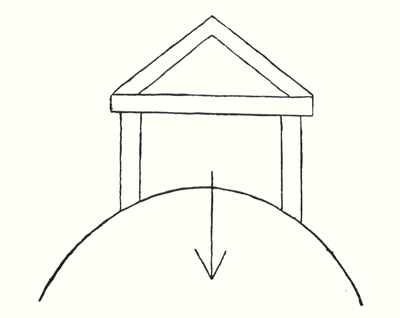
The presupposition here is that the earth with its gravity lies beneath. And translating this feeling into words, we may say: ‘In the fourth Post-Atlantean epoch man felt that the site of the earth was a gift of the God; it was as though Divine power overflowed into the creations of art.’ Therefore, by means of the forces in the earth given to man by the Gods, it was felt that gravity could be overcome. In the Greek Temple man controls the force of gravity and thereby creates a dwelling place for the God who has given him the earth.
Neither this “dwelling-place of the God” nor the later Roman Temples can be thought of apart from the surrounding land. The land is part of the Temple itself. A Greek Temple is complete in itself even if nobody is within it, for its whole conception is that of the dwelling-place of the God; it is the sanctuary of the God. Human beings may live for miles around in the district; if nobody enters the Temple, it stands there, none the less, complete in itself—a dwelling-place of the God. In every detail we see how man expresses in the decorative forms of these dwelling- places of the Gods all that his feeling of veneration makes him feel he ought to do for the Gods. In the last lecture I tried to show you that the motif on the capitals has its origin in a dance motif—a dance that was performed as homage to the Gods of nature. And now let us pass on to the forms of the earliest Christian architecture. One thought in particular arises within us when we pass from the Greek Temple to the Church of Christendom. The Greek Temple stands within its surrounding territory, belongs to the territory. Human beings are not necessarily within the Temple; they live around it, outside it. The Temple belongs to the surrounding territory, is thought of as the altar of the land around it. The Temple hallows everything, even the trivial daily occupations of the human beings who live on the land. Service rendered to the earth becomes a divine office because the God stands or is enthroned as Lord and participates in the work on the land and in the pursuits of human beings living around the Temple. Man feels himself united with the God as he works on the land. Worship of the God is not yet separated from service to the earth. The Temple grows out of the human element, sometimes indeed out of the ‘all-too-human,’ and hallows everything around it. ‘Earth, be thou strong!’—This is the prevailing mood of the fourth Post-Atlatean epoch, when human beings are still at one with the earth which the Gods have given into their charge, when the Ego is still slumbering in a kind of dream consciousness, when man still feels himself connected with the Group-Soul of the whole of humanity. Then man grows out of this Group-Soul, becomes more and more individual, and he separates from the land, from daily life and activity, the worship he performs in his spiritual life.
In the early days of Christianity the feelings of men were no longer the same as in the Greek age. Looking into the soul of the Greek, we see him sowing his fields and working at his industrial pursuits, pervaded by this unshakable feeling: There stands the Temple with the in-dwelling God and I am near. I may be carrying out my pursuits and working on the land but all the while the God is dwelling there within the Temple. Then man grows more individual, a strong sense of Ego, of “I” arises within him, and Christendom represents the emergence of something that had been prepared through the course of long ages by the ancient Hebrew civilisation. Out of the human soul arises the need to separate off from the affairs of everyday life the worship that is offered to the God. The building is separated from the land and the Church of Christendom comes into being. The land becomes independent; the building becomes an entity independent of the territory; it is an ‘individuality’ complete in itself. The Greek Temple was still a kind of altar for the whole territory, whereas the walls of the Christian Church now form a space set apart for those who are to worship. The forms of the Churches of Christendom and also of Roman architecture gradually come to express this individual, spiritual need of man, and they can only be understood in this sense. The place of the Greek within earthly existence was such that he said to himself: ‘I can remain here with my flocks, carrying out my occupations, doing my work on the land, for the Temple stands there like an altar for the whole countryside: the God is dwelling within it.’ In Christendom, man says: ‘I must leave my work and repair to this building, for there I must seek for the Spirit.’ The service of earth and the service of heaven are separated and the Christian Church more and more assumes a form where Greek and Roman architecture would no longer be suitable. It is a form which reveals that the community belongs to the church; the church is intended to enclose the community. Then, once again set apart from the community, we find the house of the priests, of those who teach. An image of the universe comes into being; the Spirit speaks to those who seek for the spirit, in precincts where they are enclosed within walls. The whole world was felt by the Greeks and Romans in former times in the same way in which the Christians afterwards felt the precincts of the Church with its enclosing walls.
And what the Greek Temple itself had been now became the chancel. Men sought now for a distinct image of the world whereas formerly they had taken the world itself and only placed within it, visible to outer senses, the Temple as the dwelling-place of God. Gothic architecture is really only a branch of what was already being prepared. The essential feature of Gothic architecture is that the weight is taken away from the walls and placed upon the pillars. What is the origin of this whole mode of construction, where the weight rests on pillars, which are so moulded that they are able to bear it? It is based on a quite different conception from that of the Greek Temple. When we pass to the pillars of Gothic architecture which take away the weight from the walls, we are no longer concerned with the pure force of gravity. Here, man himself is working. In the Greek Temple it is as though he frees himself from the earth's gravity and having gained knowledge of it within the earthly realm, now rises above it. In that man makes use of the force of gravity, he overcomes it. In the weight-bearing Gothic pillars we are no longer concerned with the pure working of the force of gravity; in the Gothic building the art of handicraft is necessary, of higher and lower handicraft. The need for the creation of precincts which enclose the community also gives rise, in Gothic architecture, to the need for something wherein the activity of the community plays a part. In the single forms we see a continuation, as it were, of what the people have learnt. The art of the hand-workers flows into the forms, and in studying these forms we see the art of human beings who have contributed their share, who have worked together. The old Roman Churches are still edifices which enclose the God. The Gothic Church is an edifice built by the community to enclose the God but one where the people have contributed their own handicraft. They do not only enter the Churches but they themselves work at the building as a community. In Gothic architecture this labour of human beings unites itself with the Divine. The souls of men no longer receive the Divine as a matter of course; they do not only come together and listen to the word of the Spirit proceeding from the chancel, but they gather around the God in their labours. Gothic Churches are really crystallised handicraft.
We can quickly pass over what came next, for it really amounted to a revival of classic architecture. In this connection it is not necessary to speak of the Renaissance; we will speak of what the fifth Post-Atlantean epoch demands of us.
Let us consider the element of weight and support, following it to the point where it becomes crystallised handicraft in Gothic architecture.
If we penetrate this with artistic feeling we realise that here is something at rest within itself, at rest within the earthly forces. All the forces of these edifices rest within the earthly element. The Greek Temple everywhere indicates the force of gravity and its own union with the earth. In the Greek Temple we can everywhere observe some manifestation of the force of gravity. Its very forms reveal a union with the earth.
And now let us compare the basic form in our building that will confront everyone even from the outside. I will make a rough diagram of it. What is the characteristic of this motif? 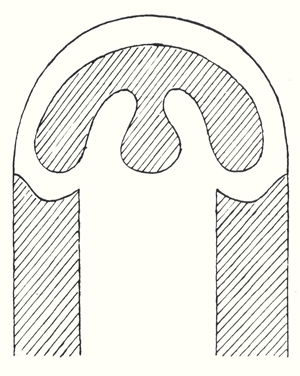 If you compare it with the Greek Temple you will discover the difference. The Greek motif is complete in itself. This other motif, when it is a wall—for instance the separate perpendicular wall—only has meaning when it is not merely wall, but when it grows out of the whole. The wall is not merely wall, it is living, just like a living organism that allows elevations and depressions to grow out of itself. The wall lives—that is the difference. Think of a Greek Temple. Although there are many columns, the whole is none the less governed by gravity. In our building, however, nothing is mere wall. The forms grow out of the wall. That is the essential thing. And when we pass around inside our building we shall find one plastic form, a continuous relief sculpture on the capitals, plinths, architraves. They grow out of the wall, and the wall is their basis, their soil, without which they could not exist. There will be a great deal of relief carving in wood in the interior of the building, and forms which, although they are not to be found elsewhere in the physical world, represent an onward flowing evolution. Beginning between the Saturn columns at the back, there will be a kind of symphonic progression to the culmination in the East. But the forms are no more present in the outer physical world than melodies are present there. These forms are walls that have become living. Physical walls do not live, but etheric walls, spiritual walls are indeed living.
If you compare it with the Greek Temple you will discover the difference. The Greek motif is complete in itself. This other motif, when it is a wall—for instance the separate perpendicular wall—only has meaning when it is not merely wall, but when it grows out of the whole. The wall is not merely wall, it is living, just like a living organism that allows elevations and depressions to grow out of itself. The wall lives—that is the difference. Think of a Greek Temple. Although there are many columns, the whole is none the less governed by gravity. In our building, however, nothing is mere wall. The forms grow out of the wall. That is the essential thing. And when we pass around inside our building we shall find one plastic form, a continuous relief sculpture on the capitals, plinths, architraves. They grow out of the wall, and the wall is their basis, their soil, without which they could not exist. There will be a great deal of relief carving in wood in the interior of the building, and forms which, although they are not to be found elsewhere in the physical world, represent an onward flowing evolution. Beginning between the Saturn columns at the back, there will be a kind of symphonic progression to the culmination in the East. But the forms are no more present in the outer physical world than melodies are present there. These forms are walls that have become living. Physical walls do not live, but etheric walls, spiritual walls are indeed living.
I should have to speak for a long time if I wanted to show that this is how the art of relief first assumes its real meaning, but I will only give you an indication of what I really have in mind. A certain eminent artist of modern times has spoken a great deal about the art of relief and has said some clever things. He tells us to think of two panes of glass standing parallel to each other and between them an intersected figure. We should then be looking in the direction of the arrow through the panes of glass at the figure ... 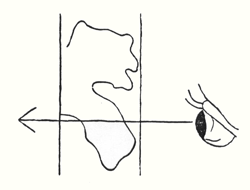 (Dr. Steiner here read a passage from a book) ... The author is trying to form a conception of what relief really is. But the conception is built up simply from what the eye perceives, as he plainly shows when he says that the relief is produced when one thinks of the background as a pane of glass and that which lies in front of the pane as shut off by another pane of glass. He therefore bases his conception of relief on the eye and in order to make it clear he uses the two panes of glass on which the whole figure is projected. As against this conception we have our own which passes over from what is made visible by glass and projection to that which lives. We want to make relief a living thing. Relief has no meaning when one simply designs figures on a wall. It only has meaning when it calls forth the intuition that the wall itself is living and can bring forth the figures.
(Dr. Steiner here read a passage from a book) ... The author is trying to form a conception of what relief really is. But the conception is built up simply from what the eye perceives, as he plainly shows when he says that the relief is produced when one thinks of the background as a pane of glass and that which lies in front of the pane as shut off by another pane of glass. He therefore bases his conception of relief on the eye and in order to make it clear he uses the two panes of glass on which the whole figure is projected. As against this conception we have our own which passes over from what is made visible by glass and projection to that which lives. We want to make relief a living thing. Relief has no meaning when one simply designs figures on a wall. It only has meaning when it calls forth the intuition that the wall itself is living and can bring forth the figures.
Now there is in the world a relief which is full of meaning, only we pay no proper attention to it. There is a certain relief that has been created in accordance with the true idea—it is the earth with her plant kingdom. We must, however, pass away from the surface of the earth into cosmic space before we can study this relief. The earth is the living surface which brings forth its creatures from its own being. Our own art of relief must be based upon the conception that the wall is a living thing even as the earth brings forth her plants. This is how a true art of relief is attained. To go beyond this principle is to sin against the essence of the art of relief. When we look down upon the great relief of the earth, we see human beings and animals moving upon it, but they do not belong to the relief. They can be introduced into the relief, of course, because the arts can be developed in all directions, but this is no longer the pure essence of the art of relief.
Our building must speak through the forms in its interior, but the speech must be that of the Gods. Think for a moment of the life of human beings on the earth, that is to say, immediately on the surface of the earth. Here we need not draw directly on our teachings—we need only turn to the Paradise Legend. If man had remained in Paradise he would have looked upon the wonderful relief of the earth with her plant kingdom from outside. He himself, however, was transplanted, as it were, into this relief. He could not observe it from outside for he was taken out of Paradise. The speech of the Gods cannot ascend from the earth to men for the speech of the earth drowns the speech of the Gods. 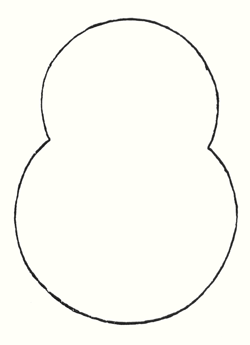 If we pay heed to the organs of the Gods which they themselves created when, as the Elohim, they gave the earth to man, if we pay heed to the etheric forms of the plants and mould in accordance with them, we are creating in the same way as nature created the larynx in man in order that he might speak—we are indeed creating a larynx through which the Gods may speak to us. If we hearken to the music of the forms on our walls which are the larynx for the speech of the Gods, we are seeking the way back to Paradise. I will speak of painting in another lecture. To-day I want to speak of the relief work and sculpture which will be produced in this house we have opened to-day. I have tried to explain how relief may become an organ for the speech of the Gods and on some future occasion we will speak of how colours become soul-organs for the speech of the Gods. Our age has little understanding for the kind of conceptions that must inspire us if we are really to fulfil our task. The Greek Temple was the dwelling place of the God, the Church of Christendom the framework around the community who would fain be united with the Spirit. What is our building to be? This is already revealed in its ground-plan and rounded form. The building is bipartite but the architectural forms of the two sections have equal importance. There is no difference as in the case of the chancel and the space for the congregation in a Christian Church.
If we pay heed to the organs of the Gods which they themselves created when, as the Elohim, they gave the earth to man, if we pay heed to the etheric forms of the plants and mould in accordance with them, we are creating in the same way as nature created the larynx in man in order that he might speak—we are indeed creating a larynx through which the Gods may speak to us. If we hearken to the music of the forms on our walls which are the larynx for the speech of the Gods, we are seeking the way back to Paradise. I will speak of painting in another lecture. To-day I want to speak of the relief work and sculpture which will be produced in this house we have opened to-day. I have tried to explain how relief may become an organ for the speech of the Gods and on some future occasion we will speak of how colours become soul-organs for the speech of the Gods. Our age has little understanding for the kind of conceptions that must inspire us if we are really to fulfil our task. The Greek Temple was the dwelling place of the God, the Church of Christendom the framework around the community who would fain be united with the Spirit. What is our building to be? This is already revealed in its ground-plan and rounded form. The building is bipartite but the architectural forms of the two sections have equal importance. There is no difference as in the case of the chancel and the space for the congregation in a Christian Church. 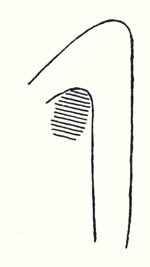 The difference in the dimensions of the two sections of our building merely signifies that in the large cupola the physical preponderates and that in the small cupola we have tried to make the spiritual predominate. This very form expresses aspiration to the Spirit. Every single detail must express this aspiration to the Spirit, inasmuch as we are striving to create an organ for the speech of the Gods. I have said that those who really understand our building fully will put away lying and unrighteousness; the building may indeed become a ‘Lawgiver,’ and the truth of this can be studied in the different forms and in the architraves. Everything in the building will have an inner value. Every part of the larynx has inner value; no words could be uttered if the larynx did not contain a a particular form at the right place. If, for instance, we were to make an indention here (see diagram) and think of a kind of roofing over it, the whole form expresses the fact that this building must be filled with the feeling of hearts striving together in love.
The difference in the dimensions of the two sections of our building merely signifies that in the large cupola the physical preponderates and that in the small cupola we have tried to make the spiritual predominate. This very form expresses aspiration to the Spirit. Every single detail must express this aspiration to the Spirit, inasmuch as we are striving to create an organ for the speech of the Gods. I have said that those who really understand our building fully will put away lying and unrighteousness; the building may indeed become a ‘Lawgiver,’ and the truth of this can be studied in the different forms and in the architraves. Everything in the building will have an inner value. Every part of the larynx has inner value; no words could be uttered if the larynx did not contain a a particular form at the right place. If, for instance, we were to make an indention here (see diagram) and think of a kind of roofing over it, the whole form expresses the fact that this building must be filled with the feeling of hearts striving together in love.
Nothing in this architecture is there for its own sake alone. The one form leads over into the other; or, if the forms have a threefold character, the central form is the bridge between the other two. Here we have a rough sketch of the forms of the doors and windows.
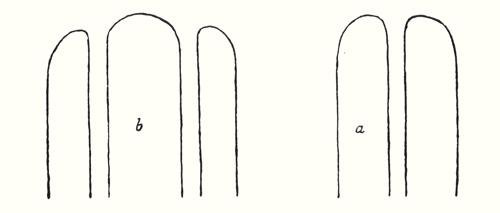
Now all that lives in the sculptured forms is three dimensional; relief is a conquest of the second dimension, surface, which is then brought into the third dimension. This is not realised if we merely take the standpoint of an observer or spectator: for we need a living feeling of how the earth allows the plants to grow out of her being.
When I come to speak of the real nature of painting we shall understand the significance of the connection between colour and the inner element of soul in the universe. There would be no sense in painting with colours if colour were not something quite different from what physics imagines it to be. The principles of colour as the speech of the soul of nature, of the soul of the universe, will be the subject of a later lecture.
I will now indicate how our glass windows are to represent the union of the outer with the inner. They will each in themselves be of one single colour, but different colours will be used at the various positions in the building. This expresses the spiritual, musical harmony of the outer with the inner world. And the single coloured window will only express this harmony in the thicker and thinner strata of the glass. That is to say, we shall have surfaces where the glass is thicker, more solid, and surfaces where the glass is thinner. The light will shine more strongly through the thinner places in the windows; it will shine less strongly, and produce darker colours, through the places where the glass is thicker. The connection between spirit and matter will be expressed in the glass windows; but the whole interior will strive to be an organ for the speech of the Gods. The larynx makes it possible for man to speak, and in the same way the whole of our relief-moulding is an organ for the Gods who should speak to us from all sides of the universe. So that when we make an aperture for the windows in the walls which allow the Gods to speak to us, we are seeking the path to the Spirits of the cosmos. These windows are intended to signify in their coloured shadings: ‘Thus, O man, thou findest the path to the Spirit.’ We shall see how the soul is connected with the spiritual world when it sleeps during the night and is living outside the body. We shall see the way in which the soul is connected with the spiritual world between death and a new birth in the disembodied state. The windows will show us how, when man approaches the threshold, he becomes aware of the abyss; the stations on the path to the spiritual world will be revealed. They will arise as light formations from the West, revealing to us the mysteries of Initiation. We are trying to create walls, the forms of which make the wall themselves seem to pass away. The designs must express how we pierce the walls, showing us how we find the path to the spiritual worlds, or traverse these worlds unconsciously, showing us what our relation to the spiritual worlds must be.
The Greek Temple, the dwelling place of the God, and the later edifice, which was built for the community desiring to be united with their God, were building-sheaths which enclosed and shut off. Our building must not shut off anything in the universe; its walls must live, but live in accordance with truth itself. Truth flows into the beauty of our relief-moulding. If we had not been driven out of Paradise we should be conscious of the ' speaking ' relief proceeding from the earth herself in the plant forms, which grow even above the geological formations of the mountains and only allow these strata to be bare in places where it is right that they should be bare. The moment however when we find in our perceptual life the transition from the 'repose' where the Gods speak to us, from that ‘repose’ to our own activity, to what we must do in order to find the way to the Gods—in that moment we must have movement, inner movement; we must pierce the wall. We must have these windows which call to our souls to tread the path to those regions whence the words expressed by the forms of the walls have proceeded. Then each one of us will sit within the building and we shall say to ourselves: “The organs of the great Spirits themselves are round about us; it is for us to understand the language spoken though these forms.” But we must understand it in the heart and not merely be able to grasp it intellectually.
Those who begin to, explain' the meaning of these forms are on the wrong track. They stand on the same ground as those who interpret the old myths symbolically and allegorically, and imagine for instance, that they are advancing the cause of Theosophy. A man who tries to ‘interpret’ the myths and explain external forms may be clever and ingenious but he is like one who tries to look under his chin to explain the symbolism of his larynx. We understand the speech of the Gods by learning how to listen with our hearts, not by using intellectual agility and giving symbolic or allegorical meanings to myths and artistic forms. ‘Here you sit and the Spirits of the Universe are speaking to you’—this must become a living feeling within us. When this becomes a living perception of what the soul must do if it is to find the way to those regions whence the speech of the Spirits proceeds, we shall direct our gaze to where the walls are pierced by the windows; and at those places there will be revealed to us the mysteries enacted in man as he consciously or unconsciously treads the path from the physical to the spiritual.
I have tried to express the feelings of our hearts and souls to-day when this house is being given over to the charge of our friend Rychter and his colleagues for their work. May they feel, as they receive it, the sacred nature of their task and something of the holiness of which I have spoken. Up on the hill itself we are still working at the building which will reveal, to those who seek, organs through which the Gods may speak to them. But there must arise in these seekers a holy longing to find the ways and paths to the realms of the Gods. The work of Rychter and his colleagues in the rooms of this house will be taken up the hill and placed in the positions where the walls are pierced. It will move the souls of those gathered together in the building at the top of the hill and show them the path to the Spirit.
May this holy mood pervade this house; may each drilling in the glass be carried out with the feeling: ‘Here I have to mould something that will lead to the realms of the Spirits those who see it up there in the building. My creations must make the soul's perception so living that the shadings in the coloured glass will represent the channels by which the spiritual worlds are speaking through the forms in the interior.’ The difficulties may be very great, indeed there may be only partial success in many cases and in other cases total failure, but the attitude I have described will be an unfailing help.
I did not intend to-night merely to speak of matters which may help to make art more intelligible. I have spoken as I have because I pray that something of what I feel may flow from my heart to yours. I want your hearts to be livingly permeated with a feeling inwardly vibrant with the sense of the holiness of this work. We dedicate this house of labour most fitly if as we leave the doors we concentrate with all the forces of our hearts on love for the world of man and of spirit, to the end that the way to the Spirit may be found through what is accomplished here—to the Spirit whence peace and harmony can flow among men on the earth. If all our labours are made living by the Spirit, if all the work on this hill is filled with the Spirit of Love—which is at the same time the Spirit of true art—then from our building there will flow out over the earth the spirit of Peace, of Harmony, of Love. The possibility will be created for the work on this hill to find successors; many such centres of earthly and spiritual peace, harmony and love may thus spring up in the world. Let us realise the living nature of our work in this mood of peace and loving harmony, knowing that our labours flow from the Spirit of Life itself. There have been dwelling-places of the Gods, sanctuaries of the community, and there yet will be an organ of speech for the Spirit, a building which points out the way to the Spirit. The God dwelt in the Greek Temple; the spirit of the community may dwell within the Roman or Gothic edifice; but the world of the Spirit itself must speak through the building of the future. We have seen the house of earthly forces and forms arise and pass away in the course of human evolution; we have seen the house of the union of human souls arise and pass away in the spiritual evolution of the earth. It is for us to build the house of speech out of our love for true art, which is at the same time love for true spirituality and for all mankind.
